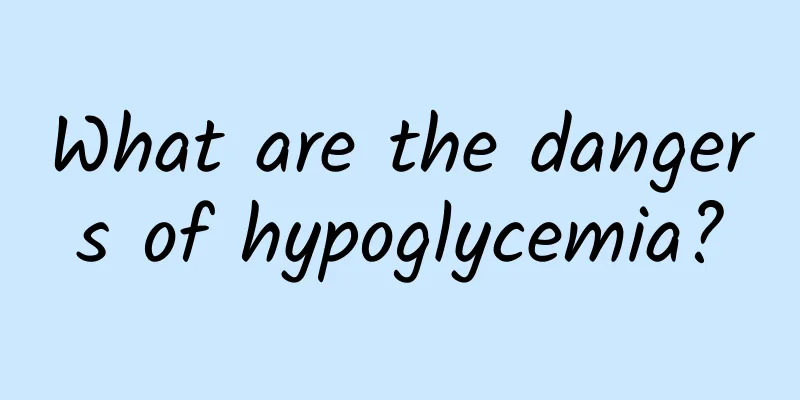What are the dangers of hypoglycemia?

|
Hypoglycemia is harmful to the human body, especially to elderly patients, where the harm of hypoglycemia is even greater than that of hyperglycemia. Today, Encyclopedia Knowledge Network will share with you some common sense in this regard, including precautions for hypoglycemia and how to prevent hypoglycemia. I hope it will be helpful to your life. Contents of this article 1. What are the dangers of hypoglycemia? 2. Precautions for hypoglycemia 3. How to prevent hypoglycemia 1What are the dangers of hypoglycemia?Hypoglycemia is harmful to the human body, especially to elderly patients, where the harm of hypoglycemia is even greater than that of hyperglycemia. The main hazards of hypoglycemia are: when hypoglycemia occurs, the body's adrenaline, glucocorticoids, glucagon, growth hormone and other glucose-raising hormones increase, leading to reactive hyperglycemia (Somogy effect), causing blood sugar fluctuations and worsening of the condition. Long-term, repeated and severe hypoglycemia can lead to irreversible damage to the central nervous system, causing personality changes, mental disorders, dementia, etc. If hypoglycemia is not properly controlled, it can be very harmful to the patient's body. In particular, adrenergic symptoms include sweating, nervousness, trembling, weakness, dizziness, palpitations, and hunger, which are attributed to increased sympathetic nerve activity and increased adrenaline release (which can occur in patients who have had their adrenal glands removed). (2) Manifestations of the central nervous system include confusion, abnormal behavior, visual impairment, stupor, coma and epilepsy. Hypoglycemic coma often has a low body temperature. Hypoglycemia can also stimulate the cardiovascular system, triggering arrhythmias, myocardial infarction, stroke, etc. 2Hypoglycemia precautionsLow-glycemic diet needs attention: 1. The staple food is generally rice and noodles, but we prefer coarse grains, such as oats, cereals, cornmeal, etc., because these foods contain more inorganic salts and vitamins, and are rich in dietary fiber. Dietary fiber has the effect of lowering blood sugar and is beneficial to controlling blood sugar. Fruits contain glucose and fructose, which can increase blood sugar. Therefore, when blood and urine sugar are relatively stable, they can be eaten between meals or before going to bed, but the corresponding staple food should also be reduced. During the period of calorie control, if you still feel hungry, you can eat vegetables with less sugar, boil them in water, add some seasonings and eat them. Vegetables are essential food for diabetics because they contain a lot of dietary fiber and water, have low heat energy and have a satiety effect. The diet should be balanced, containing at least 50-60% carbohydrates (the same dietary principles as diabetics), including vegetables, brown rice, avocado, konjac, seeds, nuts, cereals, lean meat, fish, yogurt, and raw cheese. 2. For patients with high blood sugar, soybeans and soybean products are the best sources of protein. On the one hand, they contain a lot of protein of good quality; on the other hand, they do not contain cholesterol and have lipid-lowering effects, and can replace some animal foods, such as meat. It is best not to use lard, tallow, kerosene, cream, and butter that are rich in saturated fatty acids. Vegetable oils can be used to replace some animal oils. Peanuts, walnuts, sesame seeds, and melon seeds also contain a lot of fat. Try not to eat or eat less or reduce oil intake. Egg yolks and animal offal such as liver, brain, and waist contain a lot of cholesterol, so try to use less or no cholesterol. In addition to controlling total calories, patients with high blood sugar should also have a diversified diet. However, because of the restriction of sugar and salt, the dishes have a monotonous taste. In view of this, a variety of sweeteners such as stevia and sweetened sugar have been produced on the market, which do not produce heat and do not contain any nutrients. In the past two years, a sweetener called protein sugar has been produced, which is composed of amino acids, does not produce heat, and has no side effects. It is currently an ideal sweetener, such as Newtose and Yuanzhensugar. Hypoglycemia will be fine as long as you pay more attention to your diet. 3How to prevent hypoglycemia1. Diet control should be gradual, and pay attention to eating small meals frequently, especially small snacks between meals and before bedtime. 2. The use of hypoglycemic drugs should start with a small dose and increase gradually. The speed and amplitude of blood sugar reduction should not be too fast or too large. |
<<: What is hypoglycemia? Is there any relationship between hypoglycemia and blood pressure?
>>: Seven exercises to improve limited shoulder mobility after breast cancer surgery
Recommend
How should pregnant women sleep in the last month?
Pregnant women should pay attention to their phys...
How long does it take for the induced abortion injection to occur at 6 months?
It is very dangerous to get an abortion-inducing ...
How to cure fallopian tube adhesions the fastest
The fallopian tubes on both sides are very import...
What happens when I have frequent contractions but my cervix doesn’t open?
Uterine contractions are the most direct phenomen...
Ways to facilitate implantation after ovulation
For families preparing to have children, whether ...
What to do if you have bloating during pregnancy
Women will encounter various problems during preg...
What should I do if I have allergies during confinement?
Mothers are very weak during the confinement peri...
How to prevent the skin of crucian carp from falling off when frying crucian carp soup ...
We all know that crucian carp soup is delicious, ...
What is the cause of bleeding in stool 25 days after delivery?
In fact, a considerable number of women will deve...
Coughing in the spring? Experts: Beware of "asthma without wheezing"
As spring approaches, the number of patients in t...
The harm of kidney deficiency in women, I didn't expect it to be so serious
Many women instinctively think that kidney defici...
The nucleic acid test sampling cotton swab contains carcinogens? Here comes the rumor debunking!
[This issue's rumors]: Recently, rumors that ...
Is it serious if my period is delayed for 15 days?
Female friends usually encounter the problem of d...
What to do if you have chest pain in late pregnancy
Chest pain in the late pregnancy is a symptom tha...
Hard belly during pregnancy
A hard belly in the second trimester of pregnancy...









